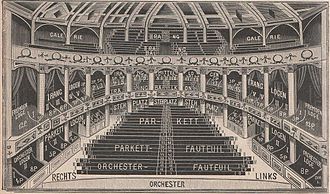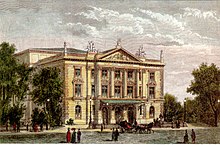Berlin theater
The Berlin Theater was a historic theater at Charlottenstrasse 90-92 in Berlin-Kreuzberg , which existed until 1936. It is best known as an operetta theater and, in the 1930s, as the venue for the Jewish Cultural Association .
history
Prehistory of the building
The original building was built by the architect Eduard Titz around 1850 on the undeveloped area of Charlottenstrasse 90-92 and only served as a venue for Circus Renz for one season. In 1852 the rentier Friedrich Gottlieb Großkopf bought the house and leased it to the impresario Rudolf Cerf , who opened it in October 1852 under the name Neues Königsstädtisches Theater . Mainly local Berlin antics were played here . Operas were rarely on the program. In 1854 the theater moved to Blumenstrasse, where Rudolf Cerf opened his royal city vaudeville theater . The theater in Charlottenstrasse was then renamed the Specialty Theater . Großkopf ran the first Berlin café-chantant there and named it Walhalla in 1856 . Großkopf had the theater rebuilt in 1869 and opened it as the Walhalla-Volks-Theater , in which one-act plays, antics, singing games, but also specialties and operettas were shown. In 1873 his son Emil Großkopf took over the management. From 1881 to 1883 it was called the Walhalla Theater (not to be confused with the Alhambra circus, which was called the Walhalla Theater since 1905 ). In 1883 the house was named Walhalla Operetta Theater . As the opening piece is played Nanon by Richard Genée that ran for over a year. Franz Steiner took over the management from 1885 to 1887.
Berlin theater
In 1888, the cultural institution was still owned by Emil Großkopf, who had left the management to the theater director Ludwig Barnay . Barnay had the facility remodeled by the Oldenburg court architect Gerhard Schnitger (1841-1917) and reopened it as a Berlin theater on September 16 with the performance of Friedrich Schiller's drama Demetrius . Barney ran the theater with one of the best ensembles in Germany until 1894 with great success. Successors were Oskar Blumenthal (until 1895), Aloys Prasch (until 1899) and Paul Lindau (until 1903). During his time, the successful piece Alt-Heidelberg was premiered in 1901 . The 500th performance took place on February 25, 1905. Sarah Bernhardt made a guest appearance here in May 1905 . In 1908 the actors Carl Meinhard and Rudolf Bernauer took over the theater and ran it until the end of the First World War. Thereafter the directorates changed frequently. Mainly operettas have been performed here since 1910, with some works by Walter Kollo premiering, for example in 1913 as in May , in 1922 also Madame Pompadour by Leo Fall and in 1923 Mädi by Robert Stolz .
Theater of the Jewish Cultural Association
In 1933–1935 the National Socialists declared the building to be the theater of the Jewish Cultural Association . He opened it with a performance of Gotthold Ephraim Lessing's Nathan the Wise , directed by Karl Löwenberg . Because of the increasing persecution of Jews during the Nazi era, this theater was the last remaining work opportunity for Jewish theater professionals in Berlin. Only artists or critics who were Jews according to the National Socialist definition were admitted there. The theater building was closed in 1935 and then torn down, ostensibly for reasons of structural safety. In 1938/39 an office building based on a design by the architects Hans Fritzsche and Friedrich Löhbach was built on the grounds of Charlottenstrasse 90-94, which among other things housed a foreigner position that placed foreign workers (presumably forced laborers ) in several trades. Today the Berlin-Brandenburg regional directorate of the Federal Employment Agency is located there . The theater ensemble, however, moved to a house at Kommandantenstrasse 58, designated as Bornemann Theater Atelier, which was liquidated in 1941. Exactly at this point, the Berlin Senate had a memorial plaque put up at the end of the 20th century (see picture), which indicates the eventful history of the 1930s and 1940s.
literature
- Berlin-Archiv , Archiv-Verlag, Braunschweig, 1980–90, collective sheet 05128
Individual evidence
- ^ View taken from the Berlin address book 1912
- ↑ Charlotte Street 92-92> construction sites . In: General housing indicator for Berlin, Charlottenburg and surroundings , 1850, part II, p. 19.
- ^ Charlottenstrasse 90–92> Cerf, theater director. and other people . In: General housing gazette for Berlin, Charlottenburg and surroundings , 1853, part II, p. 22.
- ^ Cerf, Rudolph, director of the royal city theater . In: General housing gazette for Berlin, Charlottenburg and surroundings , 1854, part I, p. 74.
- ↑ Handbook of Popular Culture: Terms, Theories and Discussions , edited by Hans-Otto Hügel, Verlag JB Metzler, Stuttgart - Weimar, 2003, p. 449
- ^ Nic Leonhardt: Pictorial dramaturgy: Visuelle Kultur und Theater im 19. Jahrhundert (1869–1899) , transcript Verlag, Bielefeld, 2007, p. 340f
- ^ Charlottenstrasse 90–92> Großkopf, owner of the Walhalla . In: Allgemeiner Wohnungs-Anzeiger together with address and business manual for Berlin , 1870, part II, p. 42.
- ^ Nic Leonhardt: Pictorial Dramaturgy: Visuelle Kultur und Theater im 19. Jahrhundert (1869–1899) , transcript Verlag, Bielefeld, 2007, p. 320
- ^ Charlottenstrasse 90–92> Großkopf, Kommissionsrath and Barnay, theater director . In: Berliner Adreßbuch , 1891, Part II, p. 78.
- ^ Charlottenstrasse 90–94> demolition . In: Berliner Adreßbuch , 1937, Part IV, p. 137.
- ^ Charlottenstrasse 90–94> Foreign Office . In: Berliner Adreßbuch , 1943, Part IV, p. 135.
Coordinates: 52 ° 30 ′ 0 ″ N , 13 ° 24 ′ 0 ″ E


